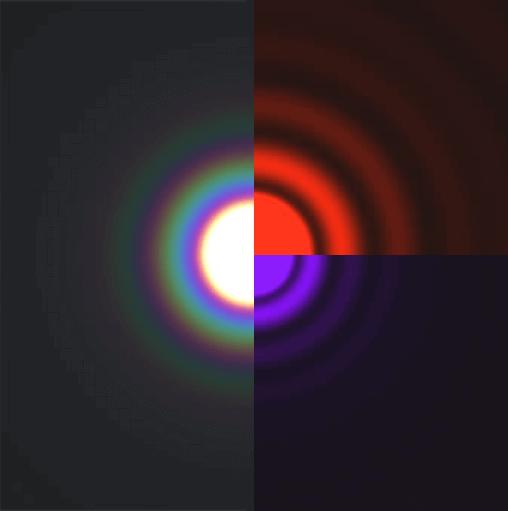Corona and Cloud Iridecence
 Michael Ellestad via AtOpt
Michael Ellestad via AtOpt
Corona
The interference of light not only results in supernumerary rainbows but also rainbow bands around the sun or moon. This is a different corona than the one that is visible during a solar eclipse (which is the outer surface of the suns atmosphere), instead this rainbow colored corona is much larger and usually caused by a thin layer of clouds over the sun or moon. Other small particles like ice crystals and even pollen can result in coronae.Corona - AtOpt
Just like with rainbows, violet light makes the smallest rings, and is closet to the center. Red light makes the largest rings on the outside of each rainbow band. The center of a corona is pure white beyond the sun because these colors overlap so much. Near the edge of the overlap we see yellow and red because they are large enough not to be cover by other colors, extending past them. This white center is called the aureole.

Like how a wide variation in drop size diminishes the visibility or supernumerary bands, drop size variation diminishes how many rainbow bands can be seen.

Like with cloudbows and their supernumeraries, the size of the drops determines the size of the corona, small drops making large corona, and large drops making small corona.
Corona Drop Size - AtOptUnlike the interference that causes supernumerary bands (coming from the light reflected within a drop), the interference that forms coronae is from light scattering off of the surface of the drop. This means that the particles diffracting the light do not have to be transparent, Modelling the Corona - Phillip Laven which is why pollen can form coronae. A corona can be formed even if the particles are not spheres (like pollen), but the corona shape changes accordingly. Pollen Corona - AtOpt
 Mikko Peussa - via USA Today
Mikko Peussa - via USA Today
Oval shape of a pollen corona
Coronas are an example of diffraction from a tiny circular barrier, eg. how light waves interact when their path is interupted by a small circular disk. It doesn't form a crisp shadow, rather it forms a larger shadow with a soft edge, and faint circular rings around it that fade out. Fresnel Diffraction: Opaque Circle - Hyperphysics The pattern is similar to that made by a circular aperture. Coronas - Hyperphysics
Cloud Iridecence
Cloud iridecence is strongly related to the corona around the sun. Most cloud iridecence is just a sun corona made by cloud water drops, but it lacks the regular circular form because the water droplets in the clouds are not uniform in size. There may be enough similar sized drops next to each other to create rainbow colors, but all around the sun the drop size varies, resulting in a wide variation of corona sizes.Cloud Iridescence - AtOpt
Here we see the regular shape of a corona distorted by the cloud structure, forming cloud iridescence.
Nacreous Clouds
Similar to iridecent clouds are the much rarer nacreous clouds which appear in smooth wavy sheets. Cloud iridecence can occur anywhere, but nacreous clouds are limited by an assortment of conditions that distinguish them:
- occur during the winter
- primarly seen in very northern climates
- higher in the sky, formed by clouds made of ice crystals in the stratosphere
- seen better at dawn and dusk because the sun still reaches high up, and they pop out against the dark sky
Next page: Glories



